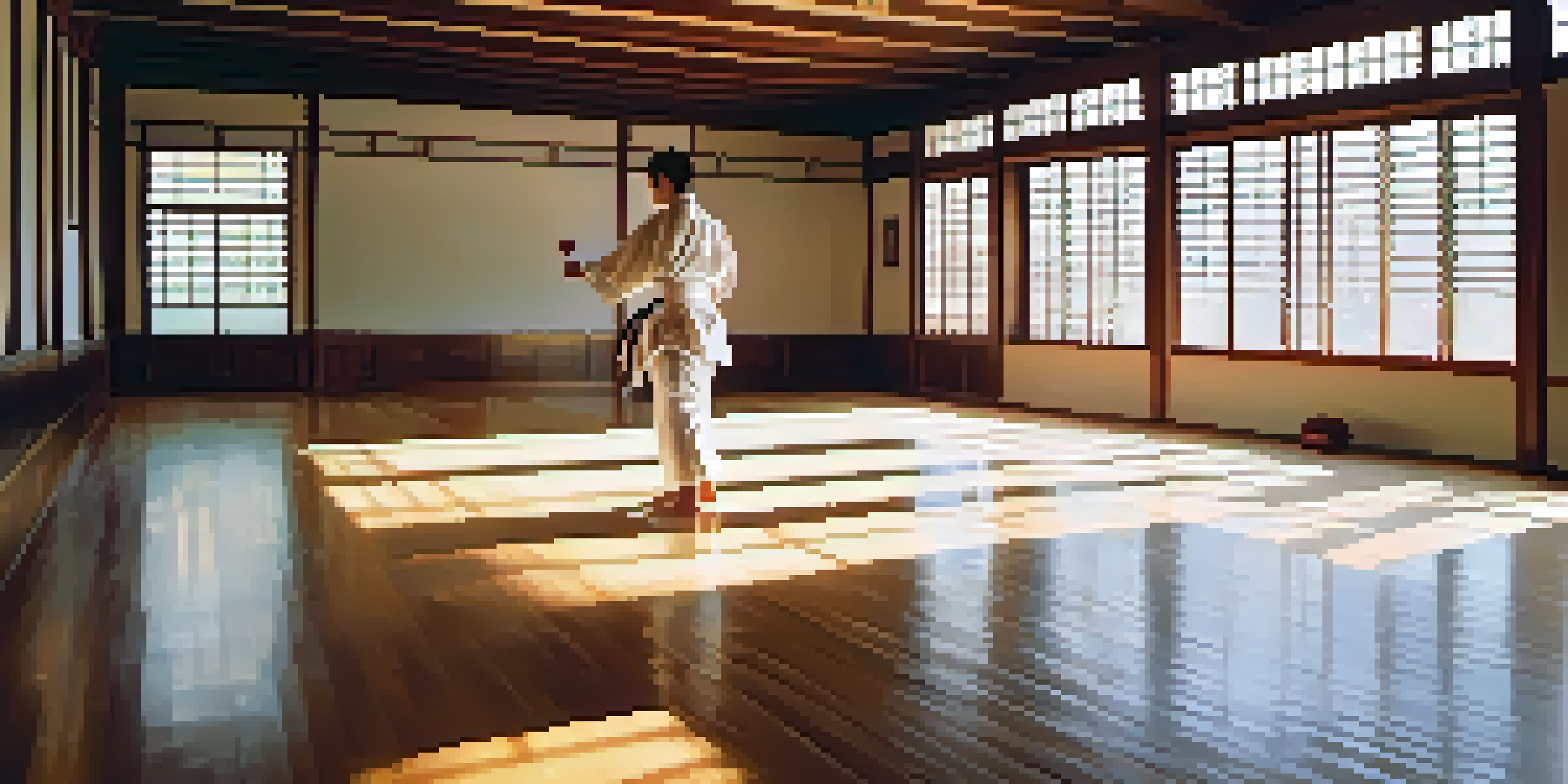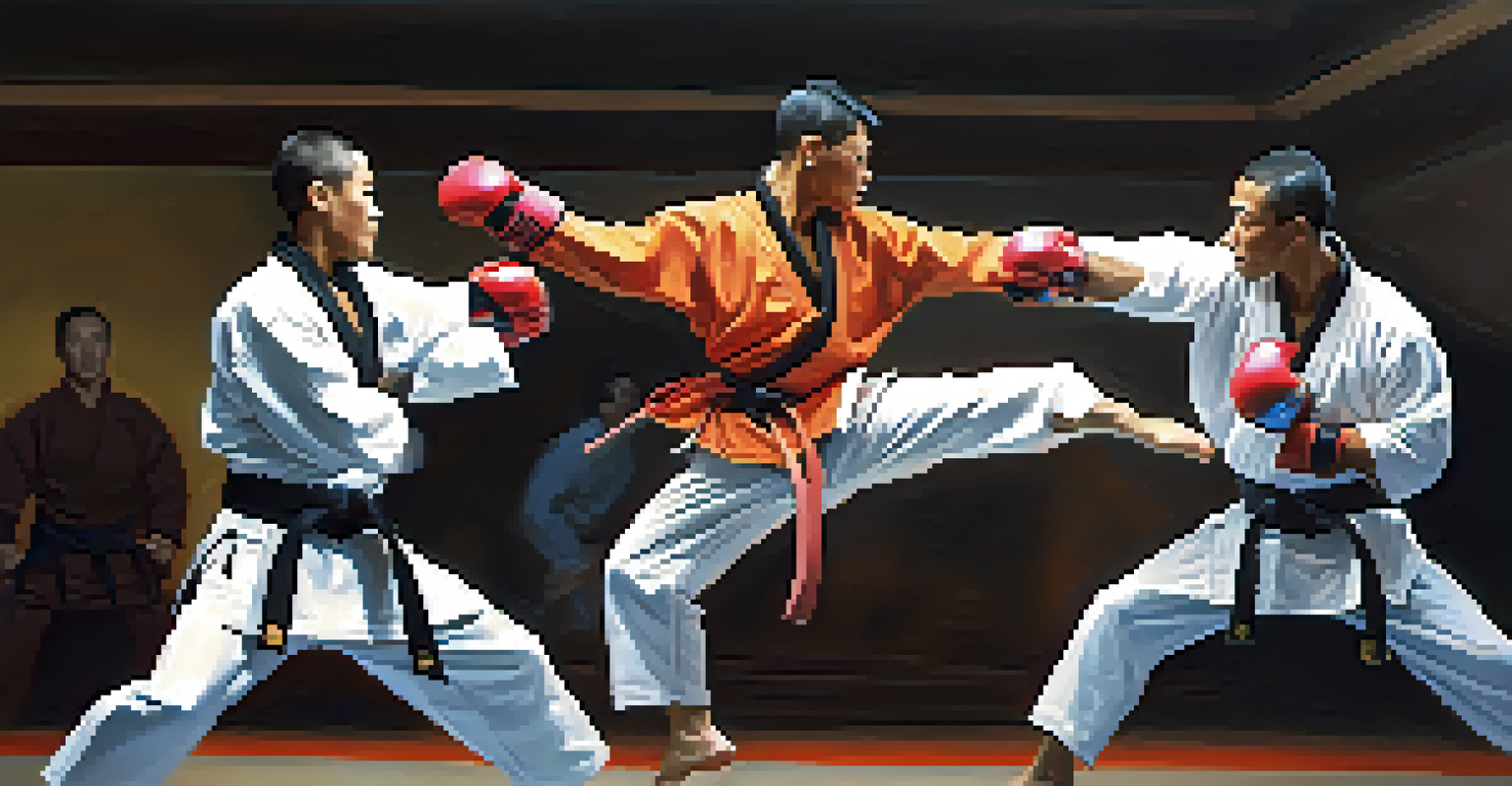Building Resilience: Martial Arts Techniques for Work-Life

Understanding Resilience: The Martial Arts Approach
Resilience is the ability to bounce back from challenges and setbacks. In martial arts, this concept is foundational, as practitioners learn to face adversity head-on. Just as a martial artist falls and rises again, we too can cultivate this skill in our daily lives.
Our greatest glory is not in never falling, but in rising every time we fall.
Martial arts teach us that failure is not the end but a step towards improvement. Each missed punch or kick is a lesson, much like the obstacles we encounter at work or home. Embracing this mindset can transform our perspective on challenges.
By adopting martial arts principles, we can build a more robust, resilient mindset. This approach not only helps us manage stress but also empowers us to face life's uncertainties with confidence.
Mindfulness and Focus: Techniques from Martial Arts
One key aspect of martial arts training is the emphasis on mindfulness and focus. Practitioners are taught to be present in the moment, which can significantly reduce anxiety and enhance clarity. By incorporating these techniques into our work-life, we can improve our decision-making and productivity.

For example, during a sparring session, a martial artist must stay aware of their surroundings and their opponent's movements. This heightened awareness can be mirrored in our daily tasks, allowing us to tackle challenges more effectively.
Resilience Through Martial Arts Mindset
Embracing failure as a learning opportunity can transform our approach to challenges and enhance resilience.
Practicing mindfulness can be as simple as taking a few deep breaths before a meeting or focusing on the task at hand without distractions. These small adjustments can lead to greater resilience in the face of stress.
Goal Setting: Learning from Martial Arts Training
In martial arts, setting clear goals is essential for progress. Whether it's mastering a new technique or preparing for a belt test, having specific goals helps practitioners stay motivated. This principle can be applied to our work-life balance by establishing achievable objectives.
The only limit to our realization of tomorrow will be our doubts of today.
When we break down our larger goals into smaller, manageable tasks, we create a roadmap to success. This method mirrors the way martial artists train, focusing on incremental improvements rather than overwhelming leaps forward.
Setting realistic goals can also help us measure our progress and celebrate small victories along the way. This practice fosters resilience, as we learn to appreciate the journey and not just the destination.
The Importance of Discipline in Building Resilience
Discipline is a cornerstone of martial arts, instilling a strong work ethic in practitioners. This discipline translates well into our personal and professional lives, enabling us to maintain focus even during challenging times. By cultivating this trait, we can enhance our resilience.
For instance, a martial artist commits to regular training, even on days when motivation wanes. Similarly, committing to our responsibilities, even when faced with difficulties, builds character and endurance.
Community Builds Resilience
A supportive network fosters resilience by providing encouragement and shared experiences during tough times.
Implementing a disciplined routine can help us manage stress more effectively, leading to improved resilience. By prioritizing consistency, we prepare ourselves to face life's challenges with greater ease.
Embracing Failure: A Martial Arts Perspective
In martial arts, failure is not something to be feared; instead, it's embraced as a vital part of the learning process. Each fall or mistake is viewed as an opportunity for growth. This perspective can significantly reshape how we handle setbacks in our lives.
When we learn to see failure as a stepping stone rather than a stumbling block, we become more resilient. This mindset encourages us to take calculated risks and step out of our comfort zones, knowing that growth often comes from discomfort.
By adopting this approach, we can foster a culture of resilience in our workplaces and personal lives, where mistakes are seen as valuable lessons rather than disasters.
Building a Supportive Community: Lessons from Martial Arts
Martial arts training often takes place in a community setting, where practitioners support and challenge each other. This sense of belonging is crucial for resilience, as it reminds us that we are not alone in facing challenges. Building a supportive network in our own lives can strengthen our ability to cope with stress.
Engaging with others, whether through martial arts or other activities, provides opportunities for collaboration and shared learning. This camaraderie can help us navigate tough times, as we can lean on each other for support and encouragement.
Discipline Fuels Personal Growth
Cultivating discipline in our routines enhances resilience, enabling us to stay focused during challenging situations.
Creating a community of like-minded individuals fosters resilience, as we share experiences and learn from one another. Together, we can face obstacles with a united front, making the journey easier and more enjoyable.
Physical Fitness: A Key Component of Resilience
Physical fitness plays a crucial role in building resilience, and martial arts provide an excellent avenue for staying active. Regular exercise not only improves our physical health but also enhances our mental well-being. This connection is vital for developing a resilient mindset.
Martial arts training involves rigorous physical activity, which releases endorphins and reduces stress. Engaging in regular physical activity can help us manage the ups and downs of life more effectively, allowing us to maintain balance amidst chaos.

Incorporating martial arts or other forms of exercise into our routines can lead to improved resilience. By prioritizing our physical health, we set a strong foundation for emotional and mental strength.